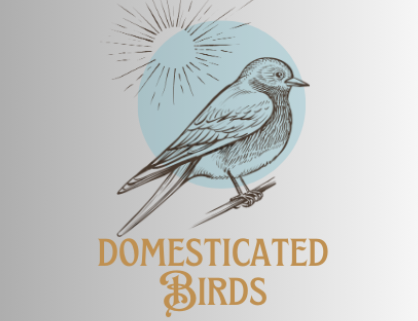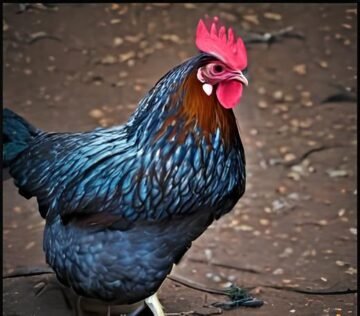Raising Blue Copper Marans, know about the origin, appearance, hen vs rooster, egg production, traits, owner suitability, benefits, price, tips, things to avoid, and many more in detail.
Introduction
If you’re looking for a breed of chicken that’s both stunning and productive, you might want to consider the Blue Copper Marans. Originating from France, these birds are not only eye-catching with their unique plumage but also exceptional when it comes to laying rich, dark-brown eggs.
Origin of Blue Copper Marans
Breeding History
The Blue Copper Maran hen is a fascinating and relatively new addition to the Marans breed, originating from the town of Marans in southwestern France. This particular variety was created by breeding Black Copper Marans with blue-feathered chickens, resulting in their unique and striking blue and copper plumage.
Key Figures in Development
While there’s speculation about Jean-Claude Periquet’s potential involvement in the creation and refinement of the Blue Copper Maran, concrete evidence is lacking.
Appearance of Blue Copper Maran hen
Blue Copper Maran Colors
Their feathers are a deep blue color with beautiful copper accents on the neck and shoulders, creating a visually appealing contrast.
Shape
These birds have a robust and well-proportioned body. They possess a broad, deep breast and a strong, upright stance. Their legs are clean (featherless) and typically dark gray or slate in color.
Blue Copper Maran Size and Weight
Blue Copper Marans are generally medium to large-sized chickens. While individual birds may vary, roosters typically weigh between 7.5 to 8 pounds, while hens usually weigh around 6.5 to 7 pounds.
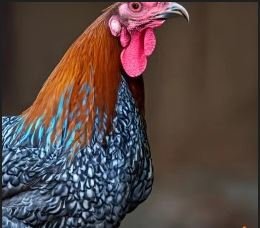
Blue Copper Maran Chicken vs. Blue Copper Maran Rooster
Physical Characteristics
Blue Copper Maran hen:
- Hens typically have a smaller size compared to roosters.
- They may exhibit more subdued copper coloring on their neck and shoulders.
- Feathers may be more uniformly colored without pronounced patterns.
Blue Copper Maran Rooster:
- Roosters are larger and more robust than hens.
- They often display more vibrant copper coloring on their neck and shoulders.
- Feathers may have more distinct patterns or markings.
Behavioral Traits
Blue Copper Maran hen:
- Hens tend to be more docile and less aggressive.
- They focus primarily on foraging and nesting activities.
- Hens may establish a pecking order within the flock but generally avoid confrontations.
Blue Copper Maran Rooster:
- Roosters are more territorial and protective of their flock.
- They may exhibit assertive behavior, especially when defending hens or territory.
- Roosters are often vigilant and may engage in dominance displays.
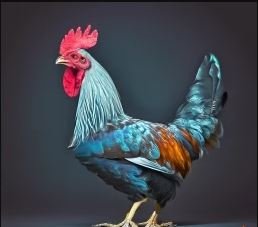
Egg Production
Blue Copper Maran Chicken:
- Hens are the primary egg producers in the flock.
- They typically lay dark brown eggs with varying frequency.
Blue Copper Maran Rooster:
- They play a crucial role in fertilizing eggs for potential hatching.
Blue Copper Maran Chicken Eggs
Blue Copper Maran egg colors
These hens lay eggs that range from a deep chocolate brown to a lighter, speckled brown.
Blue Copper Maran egg production per year
Blue Copper Marans are prolific layers, producing approximately 155 to 200 eggs per year, as reported by chicken breeders.
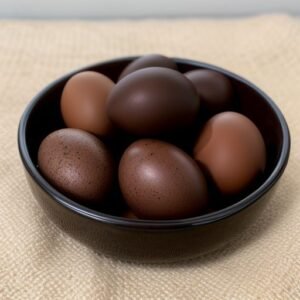
Know about factors affecting egg production of chicken, while knowing about raising Cuckoo Marans.
Characteristics of Blue Copper Maran
Before you bring Blue Copper Maran hen into your life, it’s worth diving into their captivating characteristics. Here’s why you might fall in love with them:
Temperament: Prepare to be charmed by their gentle and friendly nature. Blue Copper Marans are easygoing companions, perfect for families with children.
Hardiness: These birds are built tough. With their sturdy frame and thick plumage, Blue Copper Marans are resilient to various weather conditions.
Foraging Skills: Watch in awe as they roam your yard, expertly scouring for food. Blue Copper Maran hens have a knack for foraging, which not only enriches their lives but also cuts down on feed costs.
Health and Vitality: When it comes to health, Blue Copper Maran hens are like the sturdy oaks of the chicken world. They’re generally robust and resistant to diseases, but a little TLC with regular health checks and coop upkeep ensures they stay in tip-top shape.
Longevity: Get ready for a lasting bond because Blue Copper Marans can live for an average of 5 to 8 years with proper care.
Best Owners for Blue Copper Maran hen
You might be wondering, “Is the Blue Copper Maran the right choice for me?” Let’s break it down:
Ideal Owners for Blue Copper Marans
Families with Children: Blue Copper Maran hens are gentle and sociable, making them fantastic companions for families with kids. Their friendly nature and striking appearance can captivate children’s interest, fostering a bond that’s both educational and enjoyable.
Backyard Enthusiasts: If you love spending time outdoors and caring for your flock, Blue Copper Marans could be your feathered friends of choice. They’re hardy birds, able to adapt to various weather conditions, and their knack for foraging not only keeps them entertained but also reduces feed costs.
Those Seeking Dual-Purpose Birds: For individuals looking to get the most out of their chickens, Blue Copper Maran hens are a solid pick. They’re not only great egg layers, but their substantial size also makes them suitable for meat production. This versatility can be a boon for homesteaders or small-scale farmers looking to maximize their resources.
Not Ideal for:
First-Time Chicken Owners: While Blue Copper Marans aren’t overly complicated to care for, their larger size and specific needs might overwhelm novice chicken keepers. Starting with breeds that are more beginner-friendly can help ease into the world of poultry raising before taking on the challenge of Blue Copper Marans.
10 egg-laying chickens for beginners.
Limited Space Dwellers: If your living situation involves cramped quarters or urban settings with minimal outdoor space, Blue Copper Marans might not be the best fit. These birds thrive with plenty of room to roam and forage, so they’re better suited for rural or suburban environments where space isn’t an issue.
Benefits of Blue Copper Maran hen
Aesthetic Appeal
Blue Copper Maran hens are more than just chickens—they’re works of art. With their striking plumage and unique coloring, these birds are sure to turn heads and add a touch of beauty to your flock. Whether you’re a poultry enthusiast or an exhibitor, having Blue Copper Marans in your coop will elevate its visual appeal.
Egg Quality
Prepare to be impressed by the eggs laid by Blue Copper Marans. Their rich, dark brown hue isn’t just for show—it’s a sign of a strong shell and a deliciously rich flavor. These eggs are prized by gourmet markets and home cooks alike, adding a touch of sophistication to any dish they grace.
Dual-Purpose Breed
Looking to get the most out of your chickens? Blue Copper Maran hens are the answer. Not only do they produce high-quality eggs, but they also yield flavorful meat, making them a versatile choice for those seeking to maximize their flock’s productivity. Whether you’re after breakfast delights or savory meals, Blue Copper Marans deliver on both fronts.
Financial Benefits of Blue Copper Maran hens
Egg Sales: Harness the unique color and quality of Blue Copper Maran hen eggs to your advantage. Their distinctiveness commands premium prices in the market, presenting you with an opportunity to turn a profit. Consider selling these sought-after eggs to gourmet markets, specialty stores, or directly to discerning customers who appreciate their exceptional taste and appearance.
Breeding and Selling Birds: Take advantage of the Blue Copper Marans’ popularity by breeding and selling these prized birds. With their striking plumage and dual-purpose capabilities, they’re in high demand among poultry enthusiasts and backyard flock owners. By maintaining a well-managed breeding program, you can produce high-quality Blue Copper Marans sought after by customers willing to pay top dollar for these exceptional birds.
Exhibition and Show Opportunities: If you’re passionate about showcasing your poultry, consider entering your Blue Copper Marans in exhibitions and poultry shows. Winning accolades and recognition can increase the value of your birds and open doors to additional revenue streams, such as selling offspring from award-winning stock or offering stud services to other breeders.
Blue Copper Maran vs. Black Copper Maran
As we delve deeper into the world of Marans, our journey leads us to compare two remarkable breeds: the Blue Copper Maran and the Black Copper Maran.
Comparing Aesthetics: In our quest for the perfect addition to our flock, we pause to admire the unique beauty of each breed. While the Blue Copper Maran captivates with its striking blue plumage, the Black Copper Maran exudes elegance with its glossy black feathers.
Deciphering Egg Colors: Continuing our journey, we delve into the realm of egg colors. The Blue Copper Maran lays eggs with a lighter brown hue, while the Black Copper Maran produces eggs with a deep chocolate tone. Understanding these differences adds depth to our selection process.
Assessing Temperament: Our exploration extends to the temperament of these breeds. Both the Blue Copper Maran and Black Copper Maran are known for their gentle nature, fostering a peaceful and enjoyable environment within our flock.
Evaluating Productivity: As practical poultry keepers, we evaluate the egg-laying capabilities of each breed. Both the Blue Copper Maran and Black Copper Maran boast impressive productivity, ensuring a steady supply of high-quality eggs for our enjoyment.
Considering Market Demand: Lastly, we consider the market demand for each breed. While the Blue Copper Maran may appeal to niche markets with its unique coloring, the Black Copper Maran holds broader appeal with its timeless elegance.
Things to Avoid with Blue Copper Maran hen
Poor Nutrition: Don’t compromise on their diet. Providing quality feed and avoiding excessive treats ensures they receive the essential nutrients needed for optimal health and egg production.
Chickens season specific diet plan.
Overcrowding: Giving them sufficient space in the coop prevents stress, aggression, and disease transmission. Avoid overcrowding to maintain their well-being.
Lack of Predator Protection: Ignoring predator-proofing measures puts your Blue Copper Maran hens at risk. Secure fencing and locks safeguard them from potential threats.
Neglecting Health Checks: Regularly monitoring their health is crucial. Ignoring signs of illness or injury can lead to complications. Prompt veterinary care ensures their well-being.
Inadequate Shelter: Exposure to harsh weather conditions can harm your Blue Copper Maran hens. Providing proper shelter protects them from extreme temperatures and adverse weather.
Expert Tips for Raising Blue Copper Maran hen
Coop Comfort: Ensure your coop provides ample space and ventilation for your Blue Copper Marans to thrive.
Nutritional Balance: Offer a diverse diet to meet their nutritional needs and keep them in top form.
Health Monitoring: Stay proactive with regular health checks to catch any issues early on.
Predator Prevention: Fortify your coop against potential threats with sturdy defenses and vigilant oversight.
Enriching Environment: Keep your Blue Copper Maran hens entertained and stimulated with engaging activities.
Egg Management: Stay on top of egg collection and storage practices to maintain freshness and quality.
Blue Copper Maran hen Price
On average, you should pay anywhere from $20 to $50 per chick and $50 to $100 per adult bird. However, prices can be higher for birds from top-quality bloodlines or reputable breeders.
Conclusion
Blue Copper Maran hen emerges as a captivating breed cherished for its striking appearance and exceptional egg-laying abilities. Originating from France, these birds have captured the hearts of poultry enthusiasts worldwide. With their unique blue plumage and rich brown eggs, they add both beauty and utility to any flock. From their robust health and friendly temperament to their versatility as dual-purpose birds, Blue Copper Marans offers a wealth of benefits to owners. However, ensuring their well-being requires attention to proper care practices, including nutrition, predator protection, and environmental enrichment. By following expert advice and avoiding common pitfalls, owners can enjoy the rewarding experience of raising these remarkable birds.
How Many Eggs Does Blue Copper Maran Lay Per Year?
Blue Copper Marans typically lay between 155 to 200 eggs per year. Their egg production can vary based on factors like diet, health, and environmental conditions.
What Is the Blue Copper Maran Egg Color?
Blue Copper Marans lay eggs that range from deep chocolate brown to lighter, speckled brown. The rich color of their eggs is one of their most distinctive features.
What Is the Lifespan of Blue Copper Maran?
The lifespan of Blue Copper Marans is similar to that of other chicken breeds, averaging around 5 to 8 years with proper care.
What Are the Differences Between Blue Copper Marans and Black Copper Marans?
While both breeds share many similarities, the key differences lie in their plumage color and slight variations in temperament. Blue Copper Marans have a striking blue base color with copper highlights, while Black Copper Marans sport a sleek black base color. Both breeds are excellent layers of dark brown eggs and are known for their friendly and approachable nature.
Where Can I Find Blue Copper Marans for Sale?
Blue Copper Marans can be purchased from a variety of sources. Local breeders are often a great place to start, as they can provide detailed information about the birds' lineage and care. Online hatcheries also offer Blue Copper Marans and typically provide shipping options to your location. Additionally, poultry shows and fairs are excellent venues to find high-quality birds and connect with experienced breeders.
